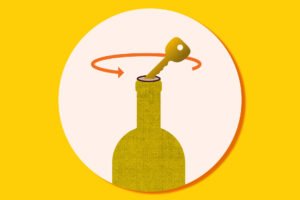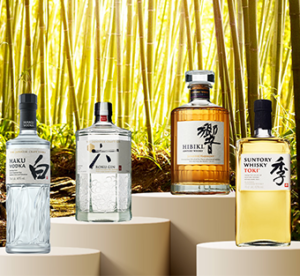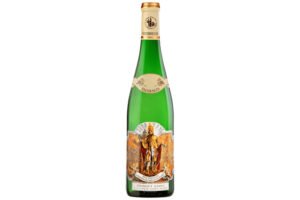Champagne Nukes its own Vineyards

[ad_1]
An about-turn on herbicide sprays reveals Champagne’s true attitude to sustainability.

© Caroline Henry/Wine-Searcher
| Vineyards near Hautvilliers have been blasted with herbicide.
Champagne’s backstep from its own environmental principles is playing out in its vineyards, which increasingly resemble a nuclear wasteland.
For the last few years, the Comité Champagne (CIVC) has been very vocal about its environmental efforts, taking every opportunity to boast about its carbon foot print reduction. Moreover, since December 2018, the region’s commitment to a “zero herbicide” policy has received plenty of air and print time.
Champagne was indeed, in 2003, the first wine region to measure its precise carbon footprint, and to significantly reduce it over the last two decades. The biggest gain has undoubtedly been the region’s semi-imposed switch to a lighter bottle a few years ago, but since then results seem to have slowed down. In February, while addressing the press, the two co-presidents Jean-Marie Barillère, President of the Union des Maisons de Champagne (UMC) up till March 31 of this year and Maxime Toubart, President of the Syndicat des Vignerons de Champagne (SGV), changed tack when addressing the region’s future and omitting the environmental engagements of 2025 (a reduction of 25 percent CO2 emissions and attaining zero herbicides) to focus instead on a new vision for 2050.
Both later confirmed that it was very unlikely that either 2025 goal would be achieved, with Toubart adding that “herbicides, when used sensibly, were likely to remain a tool for winegrowers in many years to come”.
At the beginning of April, during the Annual General Meeting (AGM) of the SGV, he went one step further stating that the omission of herbicides would not be added as an “obligation” to the region’s rulebook, better known as cahier des charges. Instead, it remains a “voluntary and pragmatic path” for the future, in other words a path which “the enlightened winegrower” should willingly take.
One could wonder what changed between December 2018 and February 2022, and the answer is simple – French legislation failed to impose the full herbicide restrictions recommended by its Agency for Food, Environmental and Occupational Health & Safety (ANSES).
To recap: in November 2018, ANSES ordered a study on the use of glyphosate with the aim of eradicating its use by 2020 in line with President Macron’s stance on the subject. The results of the study, made public in October 2020, severely restricted its use in viticulture both in quantity used per hectare and surface coverage, which had been reduced to only 20 percent of the vineyard. In September 2021, when the new legislation was passed, only the reduction in quantity used per hectare was maintained, sending out the message that the elimination of glyphosate would not be as imminent as originally expected.
This did not fall on deaf ears, and just as the legislator caved in to the pro-glyphosate lobbies, so did Toubart, who admitted to being pressured on the zero-herbicide promise when addressing the winegrowers during the SGV’s AGM.
Consequently, this has had immediate results. For the past month, many of the region’s sloped vineyards have been nuked by herbicides, changing the lush green winter landscape into something resembling a Martian desert. At Hautvillers, the UNESCO heritage-protected vineyard slopes resemble a deserted Syrian battlefield, with the burnt orange only sporadically being interspersed with a bit of greenery – coming mostly from the Moët & Chandon or Taittinger vineyards, or those of a rare organic grower.
Jérôme Vanneyken, until recently the Hautvillers representative at the Association Viticole Champenoise (AVC), estimates that only around 20 hectares of the roughly 200 hectares owned by growers are herbicide free. Luckily, nearly one third of the village’s vineyards are owned by Chapmagne houses, and it seems their vineyards have predominantly remained green. Even if most houses have made more of an effort to stay on the zero-herbicide path, it’s important to point out that some have made the same U-turn growers have. With no official figures available, one has to go on sight, and at first glance it looks like two-thirds of the village vineyards have been – at least partially – sprayed by glyphosate or other herbicides.
Back to the bad old ways
Hautvillers is not the only village baked by herbicides; a quick drive around the Côte des Blancs or the Grande Vallée de la Marne shows the same dire scenery. Many growers banked that this election season would distract the minds of the powers-that-be from the fact that they are blatantly breaking the law: the 20-percent restriction may have been lifted, but blank spraying remains illegal.
Not that this is stopping the most fervent herbicide users, who have by now often reapplied glyphosate. This is also illegal, as only one application with a restricted dose is officially authorized. However, with the CIVC in silent agreement and the SGV refusing to force herbicide restrictions, it seems Champagne has reverted to its old and trusted practices and is set to continue its excessive herbicide regime.

© Caroline Henry/Wine-Searcher
| Champagne authorities have reneged on plans to phase out herbicides and the results are evident.
With no binding restrictions, there are little incentives for growers to adopt an alternative soil management. One could hypothesize that the houses – or at least those who have so far refrained from using herbicides – could punish growers who did use them by lowering their grape price or by refusing to buy the grapes. After all, there is little point in working without herbicides when most of the grapes in the wine will come from blanket sprayed vineyards.
While this may seem logical, everyone knows this will not happen. These houses may have understood the importance of a “green” image, but they are as reluctant as the CIVC and SGV to lay down the law and enforce a change of viticultural practice.
One only needs to scratch the surface a little to see the reason why – everyone wants a large crop this year. Initial figures of the first quarter of 2022 show the yearly sales at 330 million bottles (between April 1, 2021 and March 31, 2022), the highest it has been since 2007, which many interpret as a sign that the increased sales are not just triggered by the Covid-rebound but are the new normal. Furthermore, the last two harvests have been small – 2020 for commercial reasons, and 2021 because of the inclement weather – hence the general feeling is that a big harvest is needed to prepare for future sales and restore the (partially) depleted Reserve Individuelle (RI), Champagne’s buffer system to meet the market demand in more difficult years.
Vanneycken, who is in organic conversion, told Wine-Searcher that “most producers are banking on an appellation of 12,000 kg/ha, which is easier attainable when using herbicides”.
This single-minded focus on the harvest quantity at a time that the vine barely started to bud is the main reason why ecological reforms – such as the eradication of herbicides – continue to falter. It also proves that the 2018 zero-herbicide announcement was no more than a big green-washing exercise. Several people who sat on the CIVC’s technical committee at the time have confirmed that it would have been extremely challenging to meet the zero-herbicide objective in such a short time frame and alluded the announcement had been political and commercial, rather than a real commitment.
Still, everyone agrees that today’s U-turn on the commitment without explanation or comment will only elude the reality of a zero-herbicide objective for Champagne. Wine-Searcher requests for comments from Toubart, Barillère and David Chatillon, the new president of the UMC and co-president of the CIVC, in search of an explanation for the sudden change of heart on the zero herbicide policy, potential consequences for the illegal blanket sprayed vineyards, and what this implies for Champagne’s ecological future, were left unanswered. Or in Toubart’s words: “I have nothing to say on this subject”.
Nonetheless, the results of this attitude will be felt in years to come. Besides a potential economical backlash that could (at least theoretically) result in a commercial boycott by environmentally aware wine professionals and health-focused consumers, there are more immediate ecological consequences. There is no denying that Champagne’s extensive herbicide use in 2022 will have disastrous effects on the local rivers and may even render tap water in the region undrinkable.
It also is exacerbating climate problems (which the CIVC claims to want to ease) according to Josep Maria Ribas Portella, sustainability manager at Familia Torres, and founding board member of International Wineries for Climate Action. “From a climate point of view, the wine sector should target to become as much organic regenerative as possible. This means increasing soil health, water retention, micro-diversity and carbon sequestration. This is obviously against the use of herbicides that will kill all sorts of herbs and make the soil poorer. The ideal situation would be to maintain the cover crops as long as possible, enhancing carbon sequestration.”
Interestingly, carbon sequestration through cover crops has also been part of Barillère’s plan for Champagne to reach carbon neutrality by 2050, in line with the goals set by the French government. And many big houses have indeed adopted this philosophy in their own vineyards. However, their willingness to continue to purchase grapes from growers who insist on farming using herbicides, voids their efforts.
With 1.5 billion bottles of stock, Champagne’s biggest players can afford to make the correct climate choice this year – or they can choose to look the other way and continue as if nothing is wrong.
To join the conversation, comment on our social media channels.
[ad_2]




